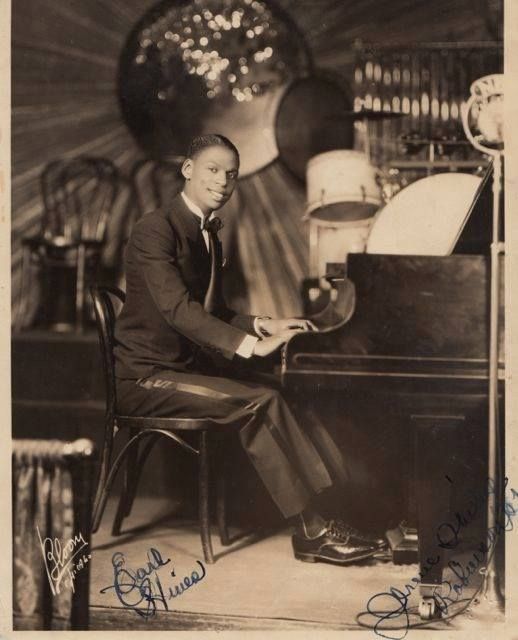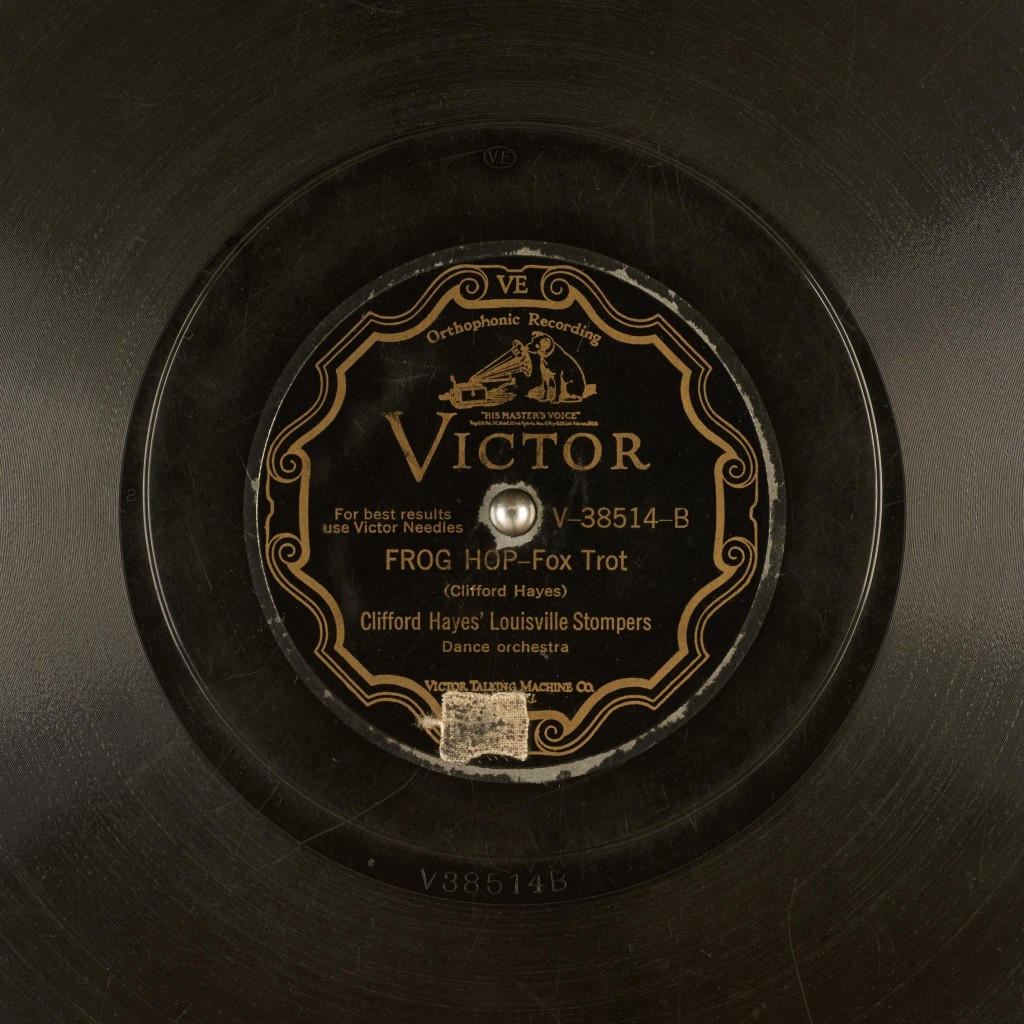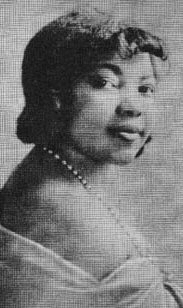Jeff Barnhart: Hal, this month we’re concluding our discussion of the music produced by violinist Clifford Hayes and Co. Starting as the Dixieland Jug Blowers, various incarnations led to the creation of the “jugless” Clifford Hayes’ Louisville Stompers; we ended last month’s column with the first full session from this quartet, recorded on May 31, 1928. They’re back again the next day, with pianist Johnny Greenwood sadly no longer sharing the chair with the more competent Dan Briscoe. The June 1, 1928 session seems a retread of what’s come before and the musicians sound a bit tired but there are some highlights. Clifford Hayes again gets credit for all four of the tunes recorded that day and every one of them is labeled as a “stomp.”
“The Petter’s Stomp” is a medium-tempo piece offering an intro, an undistinguished verse and a lovely blues chorus starting at 00:27 with Hayes playing the melody twice through on violin; the first chorus is energetically accompanied by Hense Grundy. Hal, this melody sounds like something out of the Kentucky hills; there’s hardly any jazz or blues feel to it. At 01:00, guitarist Cal Smith offers jazz phrasing to the proceedings with some bluesy bent notes on a 16-bar section going between the chords Bbm and F; even with this static harmonic pattern, his playing is still gorgeous! Smith reprises the chorus melody but with such a loose swing we’ve all but forgotten how Hayes played it. Grundy’s trombone solo is routine, but he smears nicely in chorus two. A piano interlude brings us to a final ensemble and a short ending.
“Blue Trombone Stomp” uses a chord sequence found in a great many songs from “Ballin’ The Jack” to “Sweet Georgia Brown” to “Since My Best Gal Turned Me Down.” After a chromatically descending intro, at half-speed, the tune’s taken at a super-fast tempo, showcasing Hense Grundy’s prodigious technique on two 28-bar choruses. Clifford Hayes is reduced to playing long tones due to the breakneck speed, and a rhythmic hiccup in his break causes the band to come back in early (at least everyone did at the same time!). It’s SO fast that even Cal Smith fumbles a bit yet still manages to please (I REALLY love his playing). Johnny Greenwood surprises with a rhythmically-solid left hand solo using Mortonesque descending 9th chords on the break, and a final ensemble finds everyone romping to the abrupt end.
“Clef Club Stomp” makes up for the frenetic feel of the previous tune with a relaxed tempo. Hayes has picked up his alto sax and it’s nice to have two horns in the front line. Not surprisingly, the highlight for me is Cal Smith’s guitar solo from 1:24 to 2:17. It’s a lovely chord sequence and Smith makes the most of it. Everyone sounds very relaxed on this side and it’s my favorite so far.
After a 4-bar “haunted house” intro, things crack along on “Bare-Foot Stomp” with Cal Smith leading the way. A vamp in C-minor takes us to an eight-bar violin interlude back to a double-tonguing trombone solo (what did Grundy have for breakfast before this session??) and another long-tone violin solo—it’s too bad Hayes’ intonation is inconsistent on this date. Solos for guitar (typically authoritative) and piano (rushed and uncomfortable) lead to a final ensemble ending with an unusually elaborate coda.
Hal, please share your observations about this final 1928 date. Then, I’ll leave to you the big reveal of the mystery star who we’ll hear on the eight sides the group recorded in February 1929!
Hal Smith: Jeff, I don’t really have anything to add to your comments except to once again praise Cal Smith’s guitar work. None of these performances are on the same level as the 1926 and 1927 sides. Clifford Hayes must have been extraordinarily persuasive to the Victor Company.

Having said that, I am glad that Victor agreed to record the band again, in February of 1929. Although Hayes had planned to use Johnny Gatewood again, the pianist was not available. However, one of their newest Victor artists was available: EARL HINES. This fortunate occurrance allows us to hear “Fatha” in an entirely different musical setting than Louis Armstrong’s Savoy Ballroom Five, Jimmie Noone’s Apex Club Orchestra and the solo records for Okeh and QRS. Years later, Hines was dismissive of these sessions. But listening to what he plays here, there is no sign whatsoever that Hines was unhappy with the musical surroundings!
Immediately, following Grundy’s comedic introduction to “Automobile Stomp,” you can hear Hines’ strong left hand—complete with walking tenths (not part of Dan Briscoe’s or Johnny Gatewood’s keyboard techniques)! Notice also how Hines emphasized passing chords throughout the performance. There is a beautiful, but all-too-brief piano solo too! Hines’ left hand is a complete rhythm section, supporting some introspective wandering in the right hand. Hayes, Grundy and Smith sound more energized than ever when they re-enter to take the song out. Take – 2 is even better, with Hines completing the intro with a strong melodic statement and more active accompaniment to the others’ solos. Hines’ own chorus is a masterpiece, reminiscent of his 1928 records of “Caution Blues” and “Stowaway.”
“Frog Hop” is my favorite of these records. The bright tempo, repetition of the intro as an interlude, the old-timey solos by fiddle, trombone and guitar and then…I can picture assorted jaws dropping as Hines launches into one of his typical late-1920s solos, brimming with his characteristic licks. Interestingly, Hines’ solo on the issued take is not nearly as adventurous.
Except for the Charleston rhythms, “Dance Hall Shuffle” sounds like a composition that was written long before 1929. There is even a little similarity to Harry Von Tilzer’s 1906 comedy song “Moving Day.” On both the test and the issued take, Hines provides bouncy but solid piano accompaniment to the solos by Hayes and Smith and the ensembles. There is no piano solo, but we hear some masterful upper-register fills on the final chorus.
“Shoe-String-Stomp” was an outlier: a song that Clifford Hayes did not compose. Guitarist Cal Smith gets the credit for this variation on “Bucket’s Got A Hole In It.” Smith, Hayes and Grundy take excellent solos, with Hines bubbling away underneath. There IS a piano solo on this number and “Fatha” makes the most of it, once again incorporating many of his signature phrases and riding over the top of the final ensemble on the outchorus. Hear those tremolos and that make-no-mistake ending!
Jeff, I know you can analyze and comment on the pianistic techniques much better than this drummer! What keyboard magic are you hearing on this first session?
JB: OMG! This is what I’ve been waiting for!! “Fatha” is an orchestra unto himself! Hayes and Co. have played slow tempo tunes before, but none has such a lazy, loping feel. Even though the style is still two-beat—with Hines alternating left hand on the strong beats and right hand on the after beats—in the hands of a lesser pianist (read Greenwood) there would be a distinct “boom-chick” feel. Hines is so smooth and has such harmonic command that his passing chords and gentle swing bring this ensemble into the present (for the time) day; by virtue of his accompaniment alone, everyone sounds more sophisticated.
There are innumerable touches here that Hines brings to the sound; we could devote an entire column to any one of these sides. In take 2, Hines moves further away from the two-beat feel by often strumming solid four-beat in his right hand. It’s mesmerizing to hear how he and the rest of the ensemble adapted to each other in this second take. Hines downplays the tenths and passing chords in his left hand for a more legato bass sound—almost emulating a jug in the very low bass notes he plays during the first ensemble. For their part, Hayes, Grundy and Smith are inspired with some of their best playing on record; Hayes is more sonorous than ever before and Grundy’s use of the mutes is piquant! When Cal Smith comes in, one wishes he and Hines had shared the studio more than just on these eight titles. And Hines’ solos on takes 1 and 2 greatly differ; in take 2 you hear more of that celebrated “trumpet style” octave playing he’d developed while with Armstrong. THESE sides I’ll come back to again and again.
 What a joy that Hines’ playing was so beautifully recorded! On “Frog Hop” he offers delicious walking tenths while his nimble fingering keeps things from getting too raggy. Hines’ also employs one of stride pianists’ favorite devices: he rarely holds a harmony for longer than 2 beats, using passing diminished chords in both hands to keep the forward momentum! Again, Cal Smith takes a great solo, no doubt reveling in the masterful accompaniment he’s receiving from “Fatha.” Things regress a bit stylistically during the shared trombone and violin chorus, making Hines’ explosive entrance even more striking; we seemingly leap ahead 10 years in two bars! With constantly moving rhythm in the left hand in the form of walking tenths, a bright, assertive attack in the right hand, that break—at once harmonically and rhythmically suspenseful—then the two hands chasing each other around the keys to wrap up an astonishing chorus, Hines offers 32 bars of ear-popping jazz heaven.
What a joy that Hines’ playing was so beautifully recorded! On “Frog Hop” he offers delicious walking tenths while his nimble fingering keeps things from getting too raggy. Hines’ also employs one of stride pianists’ favorite devices: he rarely holds a harmony for longer than 2 beats, using passing diminished chords in both hands to keep the forward momentum! Again, Cal Smith takes a great solo, no doubt reveling in the masterful accompaniment he’s receiving from “Fatha.” Things regress a bit stylistically during the shared trombone and violin chorus, making Hines’ explosive entrance even more striking; we seemingly leap ahead 10 years in two bars! With constantly moving rhythm in the left hand in the form of walking tenths, a bright, assertive attack in the right hand, that break—at once harmonically and rhythmically suspenseful—then the two hands chasing each other around the keys to wrap up an astonishing chorus, Hines offers 32 bars of ear-popping jazz heaven.
I agree with you regarding Hines’ solo on the take (2nd) of “Frog Hop” that was issued, but I’ll point out that the guitar solo is superior to the other one and the trombone and violin duet are much more exciting as well. Everyone was now trying to keep up with the demigod! Hines utilizes more “stridesque” figures in this solo but I enjoyed the first one more (then again, who is ANYONE to critique Earl “Fatha” Hines? That’s like saying, “Hey Zeus, I don’t really like your beard…”). However, the piano break in the final ensemble is beyond wonderful!! Seems “Fatha” was warming up to the “hickstrionics” going on around him!
What a strange tune “Dance Hall Shuffle” is, although this tempo would’ve filled a dance hall of the period. It’s an amalgamation of so many styles and tunes (such as your reference to “Moving Day”), including an almost note-for-note theft of the bridge to the previous year’s hit, “There’s a Rainbow ’Round My Shoulder.” I hear “Buffalo Gals” in there as well. It seems pretty clear why Hines didn’t solo. However, the kaleidoscopic harmonies and rhythms he uses, especially during the guitar solo (1:45-2:24; and to be really amazed, listen to the bridge: 2:05-2:14 for Hines’ left-hand responses to Smith’s guitar licks…pure poetry!) are breathtaking. His accompaniment becomes even more adventurous on the second take. He almost overdoes the “boom-chick” backing to Hayes’ violin; perhaps he was getting a bit fed up with the weakest musician at the session. Contrast that with the sophisticated backing he offers guitarist Smith. Finally, Hines pulls out all the stops on the last chorus, almost dominating the ensemble and making this a joyful romp!
The final tune from this date sounds as if they didn’t agree on what chords they would use. There are some passing chords utilized by the soloists that differ from Hines’ choices and Smith strums more assertively than usual during the trombone solo (during which Grundy sounds like he’s quoting bits of Irving Berlin’s “Mandy”). Hines’ astonishing barrelhouse entrance to his second chorus must be the highest of many high points, at least for me!! Hines incorporates more four-beat accompaniment during the 2nd take of this tune and his solo offers even more of that “independent hand” style for which he’d become increasingly famous. What riches await us in the next day’s session, Hal?
HS: There is another memorable solo by Hines on the first song recorded the following day: “Everybody Wants My Tootelum.” Hines actually starts the solo before the end of Clifford Hayes’ chorus—a Chicago style “explosion.” As before, the piano solo is Hines at his best. And note the reference to “Wild Man Blues” at the end! Cal Smith opens up with yet another expertly-played single string solo. Hayes sounds better than he has in a long time—no doubt drawing inspiration from the guest pianist. Hense Grundy drew the short straw, as there is no trombone solo. On the issued take, Cal Smith’s solo is even better. (He must have been listening to Eddie Lang records)! Hayes’ violin solo is also a step up from the one he played on the test record. Again, Hines plays a little “explosion” to launch his solo, which includes some stop-motion rhythmic devices. When the other three musicians re-enter to take the song out, they all sound supercharged!
The oddly-titled “Hey! I Am Blue” starts with an intro lifted from James P. Johnson’s “Charleston.” There are more Charleston rhythms on the verse, followed by a chorus with the violin and trombone sharing the lead. Hayes plays a chorus, then there is a particularly energetic guitar solo before the final chorus. There is no piano solo, but the issued take has some of Hense Grundy’s best trombone work to date!
“Shady Lane Blues” begins with a four-bar piano intro that leaves no doubt of the starting note and chord. Grundy and Hines pump out a relentless 4/4 as Hayes and Smith improvise. There is a bluesy violin solo, trombone with unusual plunger mute effects and single-string guitar. Are there some bars missing? Hines’ solo is uncharacteristically restricted to the middle of the keyboard. The last chorus ends abruptly after eight bars. Surprisingly, the test record has more energy and coherence than the issued version! Once again, there seems to be some indecision regarding the number of bars and where the chords change. Maybe that affected Hines and he decided to play it safe on his solo?
“You’re Ticklin’ Me” recalls Dick Oxtot’s “Ain’t Nobody Got The Blues Like Me.” After the first ensemble chorus, Hayes and Smith duet, with the guitar taking on the duties of a full rhythm section. Hines’ solo is understated; no fireworks from the keyboard. There is a trombone solo with plunger mute, then Hayes and Smith begin the final ensemble. Grundy is out for a few bars. He may have missed the cue to re-enter on this run-through, which ends abruptly after only eight bars. The issued version holds together much better, Hines solo is much more exciting and this time there are 12 bars on the last ensemble.
That was the final record with Hines. The last song of the session featured blues vocalist Sippie Wallace on piano as well as voice. Strangely, Clifford Hayes did not play on this one side. Sippie Wallace’s piano playing is very good. It was in her DNA; just listen to brother Hersal! She was a terrific singer too. The sparse accompaniment works very well. It would be nice to hear more of “Fatha,” but this is a good way to end the session.
JB: After an intro comprising the final four bars of the chorus, Hines keeps his accompaniment simple to give Cal Smith some room on the first chorus of “Tootelum”; you can feel the respect he must have had for this talented guitarist. The changes are closely based on “Beale Street Mama.” I agree everyone continues to play their best in “Fatha’s” presence. Hines’ solo exhibits such command, such effortless control, such freedom between hands; he was definitely top stud in an already thoroughbred stable of 1920s Chicago pianists. The final ensemble is sui generis with guitar, violin and trombone providing New Orleans style polyphony; Smith, Hayes and Grundy play with confidence, rarely getting in each other’s way—a skill that only develops after significant time playing together. I also find the issued take to be even better, and YES, there are some Langisms in Smith’s guitar playing!
With no solo, I’ll not dwell on “Hey! I Am Blue,” but will echo that everyone is playing perhaps beyond top form on this session and this side has an exciting bounce to it. Admittedly, on my second listening, I was gravitating to Hines’ constantly inventive accompaniment figures during the solos, but this is not my favorite, overall.
The kind of two-chord “drone” songs of which “Shady Lane Blues” is representative (others are Morton’s “Jungle Blues” and Piron’s “West Indies Blues”) leave me in the cold, perhaps because I’m a harmony player; I suspect Hines was as bored playing this one as I was listening to it. After Hines’ sneaks in an extra chord during his intro on the issued take, we yo-yo between the two chords (and as you point out, not always consistently or at the same time) until Hines’ solo! Then, he’s adding passing tones galore and I start to listen more closely! This is an iconoclastic tune and his solo style reflects this; where else in his oeuvre can you find him “strumming” repetitive tenths throughout an entire piece like a guitar? For me, Hines’ intro is more interesting on the test take (although that “extra” chord isn’t there yet). It’s honestly just weird for me to hear “Fatha” constantly thumping four-beat hits in both hands through this test take until he gets to solo!!! He reaches for more rhythmic variety in the right hand on this solo, incorporating some nice hemiolas absent from the issued take.
I think “You’re Ticklin’ Me,” a 24-bar tune comprising two related but distinct blues choruses, is a lovely finale to the collaboration between the three Kentuckians and the man from Pennsylvania! The tempo is perfect, and while the melody is nothing special (the first part seems based on the 2nd strain of “Savoy Blues”), long-time colleagues Hayes and Smith bring a poignancy to their duet. Smith shares some beautiful alternate harmonies to the blues changes and Hines picks up on those when he assumes the “strumming” role under the second part of Hayes’ solo. Hines’ piano solo, showcases passing chords once again strewn like harmonic blossoms, making the return to simpler harmonies to accompany Grundy somewhat anticlimactic. I’m grateful the test take is available to hear as well as the issued side for two reasons: I enjoyed the violin/guitar breakdown more from the test take and Hines’ solo on the issued side is completely different from the test take (no less than one would expect from a such a fecund fountain of facile fingering)!

Although Hines was not “tickled” enough to stick around for more, leaving as he did before the session was even completed, the lagniappe of “You Gonna Need My Help” on the same date makes his departure a bit less depressing. You note that violinist Hayes is absent; prosaically, he may have been in the studio lobby paying Hines for the session or trying to talk him into doing more work with the group! Sippie Wallace is indeed a great musician, blues dripping out of both her playing and singing. Cal Smith plays the melody chorus to set up the vocal and lays out on each of the vocal choruses, with Wallace singing and accompanying herself on piano; indeed, after his single-string-picking solo following Wallace’s first vocal, he disappears until a final arpeggiated chord at the very end of the side! Grundy provides sensitive backing behind Wallace’s vocal phrases: an art often underappreciated. It’s too bad this trio didn’t do some more recording together.
Hal, the futures for both Earl Hines, the most individual piano stylist of the classic jazz era, and Sippie Wallace, who can stand among Ma Rainey, Bessie Smith, and Alberta Hunter any day, are well-documented. Could you put on your “Historian Hal” hat for a moment and illuminate what happened to Clifford Hayes, Cal Smith and Hense Grundy after this session? I’ve been around them long enough now I feel as if I know them. Then, let’s share what’s coming up next month!
HS: Clifford Hayes continued to lead an orchestra (larger than the small combo heard on these recordings) that included Grundy and Smith. He also recorded one more time for Victor on Oct. 28, 1929—just before the Stock Market crashed! Johnny Gatewood was back on piano and the band was billed as “The Kentucky Jazz Babies.” Two Gatewood vocals were rejected, but Hayes’ compositions “Old Folks Shake” and “No More Blues” were released on Victor V-38616.
Pianist Dan Briscoe, who stormed out of the studio when Johnny Gatewood was brought in to play piano, had vowed to never work with Clifford Hayes again. He kept his word and got a job with the Louisville & Nashville Railroad. According to the final installment of “The Jug Bands of Louisville” (Storyville Magazine #162), Briscoe was prouder of the fact that he was one of the few African-Americans who worked long enough to earn a pension from the railroad than of his musical accomplishments!
And this article would not be complete without the story that Earl Hines told to jazz writer Stanley Dance, for Dance’s book The World of Earl Hines:
I never forget a session one snowy morning with a hillbilly group from Louisville led by a violinist named Clifford Hayes. The producer assured me the records wouldn’t be issued, but they were. I was sitting in a restaurant with Louis [Armstrong] and Zutty [Singleton] about 5 o’clock one morning when one of these records was played on the radio. “Man, that cat sounds so much like you,” Louis said, “he could be your twin brother!” We all stopped to listen, and then he said, “That is you!”
“Oh, you’re kidding,” I said. “You know I wouldn’t be playing with a group like that!”
“Well, he sure has got your style. That’s the closest I’ve heard anybody play like you.”
During the course of the record I realized it was me, but I never told Louis. If he had seen that band, I would never have heard the end of it…
Jeff, since I suggested the discussion of Clifford Hayes’ recordings, why don’t you choose our next adventure?
JB: OK, let’s listen to Charlie Johnson’s Paradise Orchestra! See you then!
Jeff Barnhart is an internationally renowned pianist, vocalist, arranger, bandleader, recording artist, ASCAP composer, educator and entertainer. Visit him online atwww.jeffbarnhart.com. Email: Mysticrag@aol.com
Hal Smith is an Arkansas-based drummer and writer. He leads the El Dorado Jazz Band and the
Mortonia Seven and works with a variety of jazz and swing bands. Visit him online at
halsmithmusic.com
























